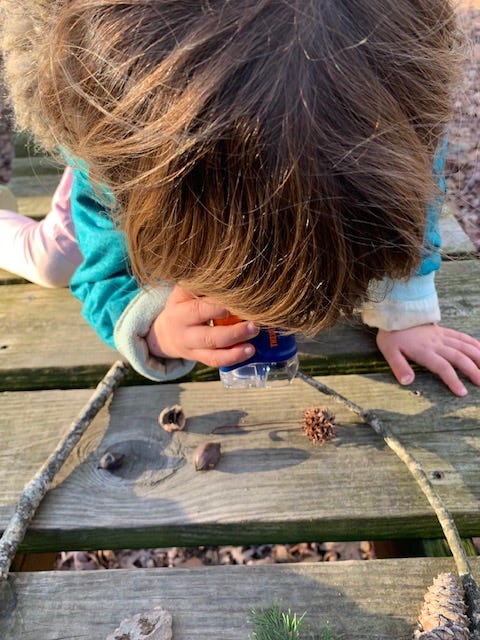In 2020, we had our old shingle roof replaced with a metal one—right before the acorn drop, which happens in September and October where we live. Our house is surrounded by oak trees, and so for a couple of weeks it sounded like someone was pelting the roof with rocks. Bang! Bang! Bang bang bang bang bang!
I like the sound of a tin roof, but the noise was a little disconcerting at first. This fall we reminded ourselves that it was about to happen and then we waited… and waited… and waited. No loud bangs. No big piles of acorns under the trees or carpeting the forest floor.
Sometime in November our friend and neighbor David texted: Where are all the acorns? What are the squirrels gonna eat?
We had no idea, and had never thought much about acorns, other than using their caps as tiny cups for fairy tea parties. Sometimes we see acorn debris on top of logs or rocks, which tells us that a messy squirrel has been feasting. We’ve looked at oak saplings. But that’s about it.
So we decided to investigate…
The first thing we learned is that acorns are a type of plant material called mast. Mast is the fruit of forest trees and shrubs, and it comes in two main types: hard mast and soft mast. Acorns, beechnuts, and black walnuts are examples of “hard mast,” which has a hard outer shell. Soft mast refers to fleshy or berry-like fruit, such as persimmons, blueberries, and wild grapes.
A “mast year” is a year in which a tree produces a LOT of fruit, ensuring future offspring and the continued health of the forest. North American oak trees produce more nuts than all the other trees in North America, wild and cultivated. For oaks, mast years happen every two to five years—in a mast year, a large oak can drop 10,000 acorns! Because producing that many acorns takes so much energy, trees grow slowly during mast years, but make up for it in the years after.
After a mast year, an oak tree will typically produce far less fruit. Mast can be affected by rainfall, climate, temperature, or even spring winds (which affect pollination), but scientists haven’t figured out the full mystery of the mast year.
Both hard and soft mast are eaten by forest animals, who depend on it for energy. Like the nuts you eat in granola, trail mix, or peanut butter (if you can eat nuts), the “meat” of acorns contains a mix of carbohydrates, protein, and fats that help keep squirrels and other animals going. Hard mast is eaten by deer, bear, squirrels, grouse, wild turkeys, quail, and many other forest animals.
Trees and shrubs depend on these animals, especially squirrels, to disperse their seeds.
Squirrels basically do this by being forgetful—or maybe just being extra-prepared hoarders? They “store” many acorns by burying them, and fail to recover up to 74 percent of these acorns. Some of these grow into trees!
Scientists have also hypothesized that through a phenomenon called predator satiation—a strategy that fills up seed-eating animals in mast years and starves them in non-mast years—trees ensure that enough acorns can grow into mature trees.
Acorns are so nutritious and abundant that some have wondered if they should be reintroduced to the human diet, or more widely used as a sustainable food?
After all, acorns were a staple for many Indigenous people for generations. In this article in Indian Country Today, Lee Allen writes:
Acorns represented life for Indigenous Peoples, figuring prominently in the diets and daily lives of countless generations—gathering acorns, processing them, cooking them, storing them, and ultimately, eating them.
“No other food has sustained the human race to such an extent as the acorn,” says biologist/herbalist John Slattery, author of Southwest Foraging. “If you took a gigantic table and laid out all the foods humans have eaten across the globe and over time, making an individual pile for each foodstuff, acorns would be, by far, the largest pile on the table.”
In pre-contact times, acorns were the preferred food resource because of their availability, productivity, storability, and nutritional content. In California, for instance, one anthropologist reported that annual production exceeded subsistence demands despite the fact that more than three quarters of the entire population relied on acorns for food on a daily basis.
On Tuesday, reader Jennifer Dianna commented that she has not had an issue with acorn availability this year—her trees seem abundant!—and she should know, because she forages for them. We asked how she processes them, and she wrote back:
first i put them in water to let the floaters come to the top to give to the squirrels. then i crack them open with a hammer. this was the most satisfying part for me! i especially loved when I would open ones that still grubs in them, watching them crawl around the squirrel bowl! then they soak in room temp water. This takes the longest but it's how you get the tannins out. you keep changing the water until the acorns taste ok. I'm keeping mine refrigerated until i'm ready to do something with them because I don't have a dehydrator and the lowest temp on my oven (150*) will cook the starch (so i've heard). But they do smell so so so good when they are roasting in the oven!
This sounds really fun—the girls love cracking things—but probably better for us to try in a mast year. Our best guess about why our trees are not masting, while Jennifer’s are, is that they are in different forests. We’ll do some more research to find out if we are right!
In the meantime, we enjoyed this PBS North Carolina video about how researchers at the US Forest Service use an annual acorn count to learn about the health of the forest:
And here’s Alexis Nikole (AKA Black Forager) on processing and cooking with acorns:
What’s up with your oak trees this year? Have you ever tried to make acorn flour or acorn pancakes?






Thanks for sharing. This was so interesting and informative! My love to all.
Sam would love this post so much! he was so excited about Va wildlife featuring flying squirrels!